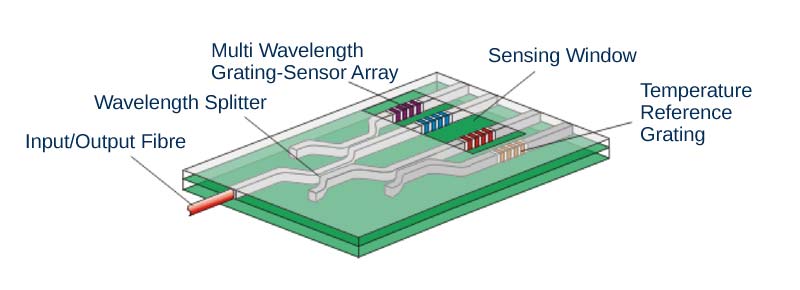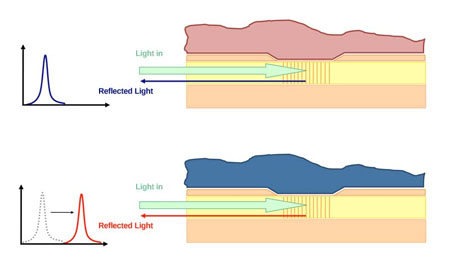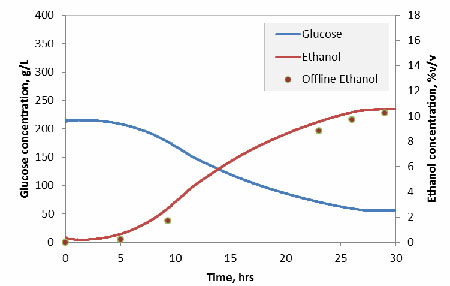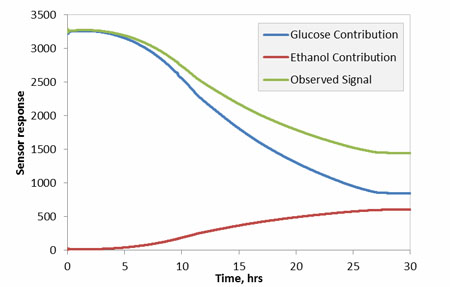Biochemical production processes can be difficult to both control and monitor. Sam Watts from Stratophase, looks at improving biopharmaceutical process control with real time, in-line monitoring tools developed from fibre optics.
The tool kit of analytical techniques currently available to monitor chemical and biochemical production processes is difficult to apply in real-time. Advances in solid state fibre optic sensing technology allow new techniques to complement the current tool kit. The use of optical in-line sensing enables real-time monitoring of production status, highlighting problems as and when they occur.
Within biopharmaceutical fermentation processes, yields can be maximised by close control of the process feedstock – for example, glucose. Timing is similarly important and entire batches can be spoiled if the process is allowed to continue just a few hours past the optimum harvest time. Continuous and final product quality control procedures are employed across the industry, but often the parameters measured, or the time delay between sampling and analysis, make it difficult to uncover and rectify any problems as they occur.
If the problems are serious enough there are major costs associated with the wasted batch – from expensive precursors, equipment time and the batch itself, not to mention the lost labour and downtime costs arising from having to clean down the whole system (or replace disposable components) and start the entire process again.
If the problems are serious enough there are major costs associated with the wasted batch
As a result, it is important to look towards integrating a range of analytical technologies that provide a real-time picture of the process.
The US Food and Drug Administration’s (FDA) Process Analytical Technology (PAT) guidelines provide an idea of what can be achieved in improved production processes based on such real-time analysis. This search for real-time information, offering increased efficiency and improved process control, echoes the FDA’s drug quality guidelines. The guidelines adopt the Quality by Design (QbD) principles, which state that quality cannot be tested into products; it should be built-in or should be by design.
Within these QbD guidelines the FDA devised its PAT initiative. PAT is an industry-wide effort to understand and optimise every step of the pharmaceutical manufacturing process by developing monitoring capabilities that enable timely control. The ultimate aim is to enhance production efficiency, quality and safety by: reducing production cycle times; minimising batch rejection; enabling real-time release; increasing the use of automation; and facilitating continuous processing.
PAT is an industry-wide effort to understand and optimise every step of the pharmaceutical manufacturing process by developing monitoring capabilities that enable timely control
QbD and PAT both set out with the aim to improve quality and reduce production costs. To achieve these goals new measurement technologies are required. An example of one such advancement that can provide online measurements in real-time is optical microchip technology. With such measurements, changes within the production process can be identified as they happen, therefore enabling the process conditions to be altered and improved, including automated fed batch control of the nutrient, such as glucose.
current methods
It is necessary to determine the physiological condition of the cells within a fermentation reaction to fully monitor its status. One commonly used technique to control the production process is following the O2 consumption and the levels of CO2 emission measured by gas analysis in the headspace of the fermenter. The ratio of these two is the Respiratory Quotient (RQ) – a well-defined parameter for monitoring biological activity, as it is dependent on the nutrient source that is being metabolised. However, it is an indirect measurement and also requires the use of mass spectrometry to provide suitable accuracy.
To provide a more robust measure of the progress of a fermentation reaction, the industry requires a real-time solution that directly analyses the fermentation media, which is easy to use, relatively inexpensive and robust enough to withstand continuous exposure to the media.
real-time monitoring
In-line, real-time measurement techniques that provide status monitoring are now being developed to provide the required analytical measurements from within the fermentation media.
NIR monitoring: Near infrared (NIR) absorption measurement is one of several spectroscopic techniques that can be provided via a fibre optic inserted as a probe into the fermentation vessel. With the probe immersed in the fluid, the spectrometer can gather in situ data about the progress of the reaction.
While NIR does provide a lot of chemical information, it is a relatively expensive technique and the development of the process model is highly complex due to the overlap in the absorption bands of the numerous analytes.
Once this model has been generated, live data needs to be collected and analysed by making comparison with it. Full interpretation of the NIR data can be complex and, combined with its relative expense, may exclude it from the remit of many bioprocessing facilities.
SSRI monitoring: To overcome the restrictions of NIR spectroscopy, Stratophase developed the Solid State Refractive Index (SSRI) monitoring technique. The SSRI system uses fibre optics combined with solid state silicon technology to detect, in real-time, how a fermentation process parameter, such as glucose, is deviating from the quality ideal. There are two components to the system, a sensor management unit (SMU) and a probe containing the solid state sensor (Figure 1).
The system can stand alone; however, it is expected that the SMU will ultimately be integrated into a full process control system.
The solid state sensor is based on the concept of integrated optical circuits. Broadband light from the SMU is coupled into an optical fibre that is connected to the microchip sensor. Light is reflected back from the sensor to the SMU and converted into a measurement specific response.
Within the microchip, the light is routed and channelled into integrated Bragg gratings, which reflect only specific wavelengths (Figure 2). The specific wavelength of the silicon Bragg grating is very sensitive to changes in the refractive index (RI) on top of the chip. The sensor detects fermentation-specific parameters as well as changes of the temperature through changes in the RI of the liquid that is in contact with the sensing window of the microchip (Figure 3).

Figure 2: Within the microchip, the light is routed and channelled into integrated Bragg gratings, which reflect only specific wavelengths

Figure 3: The sensor detects fermentation-specific parameters as well as temperature changes through changes of the RI of the liquid that is in contact with the sensing window of the microchip
The RI of a liquid is also a function of temperature, so the temperature reference is essential for relevant data to be generated. The ability to locate the temperature and RI sensing elements in close proximity (sub millimetre) enables the simultaneous identification of both parameters.
Measurements are performed in real-time, typically taking a reading twice a second. The data generated by the in situ probe is then related to compositional changes within the media.
It is the combination of refractive index (RI), temperature and condition measurements that make the technology ideal for bioprocessing applications. The sensor is sensitive to changes of less than 0.001g/l of glucose. As the glucose levels vary the system feeds the information back in real-time so that the process controller can respond immediately. An important advancement is that this enables automated real-time fed batch control of the process.
A typical measurement is shown in Figure 4. The sensor response is separated into the glucose and ethanol contribution in real-time. Figure 4 shows the corresponding concentrations derived from the measured response data. For comparison, glucose concentration measured by a conventional off-line method outside the fermentation vessel is also plotted in this graph.

Figure 4: A typical measurement. The sensor response is separated into the glucose and ethanol contribution in real-time
The simplicity of the system, with its easy-to-understand read-outs, means the data can be acted upon immediately without requiring analysis from a highly qualified scientist and the attendant time delay. The optical microchips are inexpensive to produce and as such can be disposable, making them increasingly relevant as moves are made towards single use bioreactors (SUBs). The small form factor and separation of sensor for the analysis engine means that they can be used in lab-based development reactor vessels as well as full production bioreactors. Using the same sensing technology allows for correlation of data between systems during process transfer and scale-up.
The new system is currently being trialled and integrated by process developers, equipment and product manufacturers.

Figure 5: Corresponding concentrations derived from measured response data. For comparison, glucose concentration measured by a conventional off-line method outside the fermentation vessel is also plotted
In conclusion, real-time in-line monitoring of key parameters of biopharmaceutical fermentation processes offers greater process control leading to important cost savings and increased efficiencies. Achieving this requires the introduction of additional process analytical tools such as the SSRI technology, which is easy to integrate, economic to produce and straightforward to use. The example given of real-time control of glucose feeding is a significant step forward in biopharmaceutical process control.




